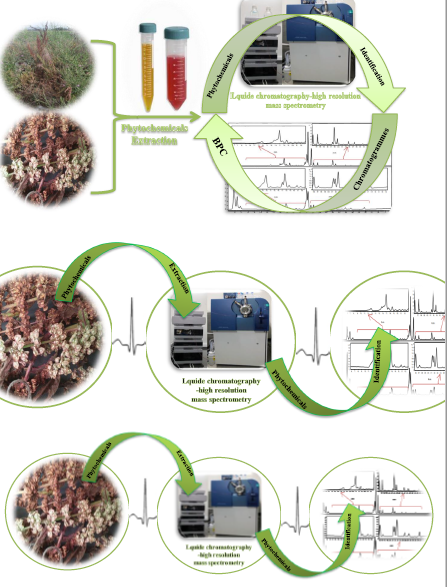The present study was designed to investigate the bioactive compound in Rumextunetanus extracts (polygonaceae), a plant growing in GarâaSejnane region (NW-Tunisia). Hydro-methanol extracts of flowers and stems of Rumextunetanus were analyzed by RP-UHPLC-ESI-QTOF-MS in the negative mode to identify the maximum of bioactive compounds. Applied the aforementioned method, a total of 60 bioactive compounds were characterized for the first time in Rumextunetanus between them, 18 photochemical were firstly identified in the Polygonaceae family in negative ionization mode. Quantification of the identified compounds revealed that quercetin-3-O-glucuronide and (-)-epicatechingallate were the most abundant phenolic compounds in flowers and stems, respectively. Moreover, positive correlations were found between the antioxidant activity measured by DPPH and FRAP assays with the total phenolic compounds (r = 0.98; r = 0.99, respectively) and the abundance of some phenolic subfamilies such as hydroxycinnamic acids, hydroxybenzoic acids, flavonols and flavones with r > 0.86. The compounds displaying significant (P < 0.01) and good correlations with the antioxidant activity (r > 0.93) were hydroxybenzoic acid, rutin, quercetin-3-O-glucuronide, quercetin-3-O-glucoside, quercetin and luteolin-7-O-rutinoside. In addition, the flowers and stems of Rumex tunetanus showed different bioactive compound profiles and significant antioxidant properties of extracts. These results highlight the potential of the RP-UHPLC-ESI-QTOF-MS and MS/MS system to identify untargeted metabolic profiling of Rumex tunetanus. Overall, these results contribute to the clear explanation of the past and current usage of genus Rumex in folk medicine. Future investigations are necessary to develop purified antioxidant extracts, with the application of more selective extraction techniques.

